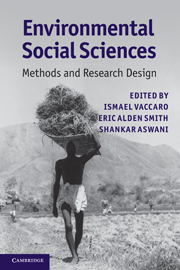Book contents
- Frontmatter
- Contents
- Contributors
- Foreword
- Preface
- 1 Introduction
- 2 People, numbers, and natural resources: demography in environmental research
- 3 Production decisions and time allocation: a guide to data collection
- 4 Analyzing the politics of natural resources: from theories of property rights to institutional analysis and beyond
- 5 Extreme events, tipping points, and vulnerability: methods in the political economy of environment
- 6 Local communities and natural resources: ethnobiology in practice
- 7 Mapping histories: cultural landscapes and walkabout methods
- 8 Metaphors and myths in news reports of an Amazonian “Lost Tribe”: society, environment and literary analysis
- 9 Water decision-makers in a desert city: text analysis and environmental social science
- 10 Linking human and natural systems: social networks, environment, and ecology
- 11 Khat commodity chains in Madagascar: multi-sited ethnography at multiple scales
- 12 Spatiotemporal methodologies in environmental anthropology: geographic information systems, remote sensing, landscape changes, and local knowledge
- 13 Deep time, diachronic change, and the integration of multi-scalar data: archaeological methods for exploring human–environment dynamics
- 14 Comparing trajectories of climate, class, and production: an historical ecology of American yeomen
- 15 Socioecological methods for designing marine conservation programs: a Solomon Islands example
- Index
- References
14 - Comparing trajectories of climate, class, and production: an historical ecology of American yeomen
Published online by Cambridge University Press: 05 June 2012
- Frontmatter
- Contents
- Contributors
- Foreword
- Preface
- 1 Introduction
- 2 People, numbers, and natural resources: demography in environmental research
- 3 Production decisions and time allocation: a guide to data collection
- 4 Analyzing the politics of natural resources: from theories of property rights to institutional analysis and beyond
- 5 Extreme events, tipping points, and vulnerability: methods in the political economy of environment
- 6 Local communities and natural resources: ethnobiology in practice
- 7 Mapping histories: cultural landscapes and walkabout methods
- 8 Metaphors and myths in news reports of an Amazonian “Lost Tribe”: society, environment and literary analysis
- 9 Water decision-makers in a desert city: text analysis and environmental social science
- 10 Linking human and natural systems: social networks, environment, and ecology
- 11 Khat commodity chains in Madagascar: multi-sited ethnography at multiple scales
- 12 Spatiotemporal methodologies in environmental anthropology: geographic information systems, remote sensing, landscape changes, and local knowledge
- 13 Deep time, diachronic change, and the integration of multi-scalar data: archaeological methods for exploring human–environment dynamics
- 14 Comparing trajectories of climate, class, and production: an historical ecology of American yeomen
- 15 Socioecological methods for designing marine conservation programs: a Solomon Islands example
- Index
- References
Summary
Introduction to historical ecology
Historical ecology uses interdisciplinary synthesis to trace and evaluate the complex relationships between humans and the environment over the long term, typically traversing the course of centuries (Crumley 1994, 2007: 16). Its methodological backbone is the synthesis of long-series data produced by practitioners in diverse fields. Work in historical ecology is guided by theoretical postulates that recognize that understanding humans’ occupation of nearly every environmental niche and the diversity of human social structures requires broadly integrative methodologies (Balée 1998). Researchers bring about a difficult union between history and science, pay close attention to the relations of geographic and temporal scales, embrace human social complexity, and present findings in ways that are broadly accessible (Crumley 1994, 1996a, 1996b, 2007).
The methods of historical ecology have been shaped by a rejection of environmental determinism, an interdisciplinary historical synthesis, and interest in questions concerning the historical trajectories of the changes in humans’ relations with the environment. Because historical ecology melds data from science and the humanities, the following review of its methods draws from advances in geography, biology, ecology, history, sociology, and anthropology. That discussion is followed by examples of questions addressed by practitioners of historical ecology, an illustrative case study, and an evaluation of the future of the approach.
- Type
- Chapter
- Information
- Environmental Social SciencesMethods and Research Design, pp. 322 - 348Publisher: Cambridge University PressPrint publication year: 2010

